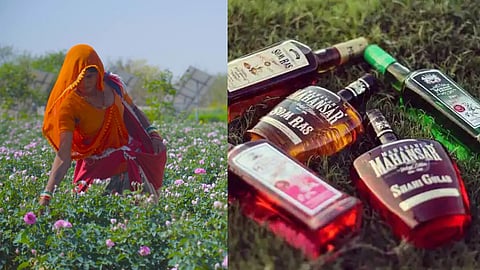
- HOMEGROWN WORLD
- #HGCREATORS
- #HGEXPLORE
- #HGVOICES
- #HGSHOP
- CAREERS
- ABOUT US
- CONTACT US

Whether they be the gland secretions from musk deer or the petals of damask roses picked at dawn, the distilleries of Rajasthan have found a way to ferment almost anything to produce legendary liqueurs that are as much a part of its cultural heritage as havelis and zari embroidery. Once haloed as the bequest of select princely families (rajwaras) and the households of their feudal lords (thikanedars), brewing recipes were zealously conserved for centuries, until the Rajasthan Excise Act of 1950 prohibited the manufacturing of desi or country liquor.
Typically stored in clay containers and distributed in ceramic bottles, the gatekeeping of asaav or royal liquor eventually succumbed to the allure of free market capitalism when many brewing families sold their trade secrets to the state-owned Ganganagar Sugar Mills (RSGSM). Reopened in 2018 after a decade-long moratorium, the production of Royal Heritage Liqueurs was believed to be facilitating 'experiential tourism', according to Dr. Prithvi Raj (IAS) who is Secretary to the Government (Agriculture & Horticulture) and also one of the managing directors of RSGSM.
The most acclaimed concoctions by the government undertaking so far have been Kesar Kasturi, Chandr Hass and Royal Saunf owing their popularity to the patent shared by the Maharaja of Jodhpur, Gaj Singh II.
I. Kesar Kasturi
Manufactured at the RSGSM distillery in Jhotwara, Royal Kesar Kasturi is no longer made from musk deer extracts after the 1972 Wildlife Protection Act declared the endangered species as a Schedule 1 animal. With earliest commercial production dating back to 1924, when the first modern distillery was established at Mandore during the times of Maharaja Umaid Singh, the original prototype was lifted from the royal cellars of Marwar.
Steeped in premium quality saffron, dry fruits and herbs, blended with ghee — this barmy, cloying brew is intended for the winter season but can be consumed on the rocks (in moderation) during the summer.
This drink is touted for its aphrodisiac qualities, apparently intoxicating the likes of Roger Moore when shooting for Octopussy or Neil Armstrong who tried it during his voluntary stint in Jaipur for the Peace Corps.
II. Chandr Hass
The name carrying a susurration of Shiva's sword that can eliminate your enemies quieter than a whisper, Chandr Hass was made accessible after 1863 by the Champawat clan of Kanota Thikana, and today it can be sipped at their Hotel Narain Niwas Palace in Jaipur.
Carrying hints of unusual elements like awlah (Indian gooseberry), nutmeg and white sandalwood — the swig is a nuanced medley of close to 80 spices, nuts and roots. Traditionally, jaggery would be fermented alongside Afghani dry fruits and jujube roots but today extra neutral alcohol is simply soaked in herbs for a few days before filtration to brew this concoction.
III. Royal Saunf
The legendary Saunf, at the outset was made by fermenting gud (jaggery) and ber (Indian date) in an earthen pot for two weeks before distilling with milk and saunf (fennel), leaving it to mature in a ceramic vessel for close to six years. Renowned for its digestive and carminative properties, this drink (like most heritage liqueurs) has its roots in Ayurveda, turning a milky white when mixed with water.
On the menu at The Leela Palace Udaipur’s luxury-dining restaurant Sheesh Mahal, Royal Saunf is also bottled as 'Sonf' by the privately owned Shekhawati Herbal Heritage, a trademark registered with the eighth generation of the Mahansar royal family. Aniseed is slipped into the distiller while processing the Sonf liqueur and a small glass of this digestif serves as the perfect nightcap after a meal.
IV. Shahi Gulab
One of the oldest players in the field, the Mahansar royal family are known for infusing their distillates with natural ingredients like honey, cardamom and cloves, often striking notes of mint with an aftertaste of spicy sweetness. The Shekhawati Herbal repertoire is presented under three brands — Royal Mahansar, Maharani Mahansar and Maharaja Mahansar — and the rose liqueur is indeed their most memorable creation.
Titled the Maharani Mahansar Shahi Gulab, the rose petals plucked from fields in Pushkar and sorted before churning with the alcohol in a copper pot, its subtly floral tincture can make for a pleasant evening cocktail.
V. Royal Mawalin
Bearing a close semblance in flavour profile to an Italian amaro spirit like Cynar, the Mawalin bears an undertone of resolute bitterness, distilled from over 42 ingredients passed down through generations by the Sodawas of Jodhpur until it was ready for general consumption in 1940. Miraculously restorative for those suffering from cold or body aches, this smooth liqueur evaporates clean off of your tongue and is meticulously served with crushed ice in summer and in a bowl of deep lukewarm water in winter. Inveigled on camelback in clay containers into faraway principalities across the country, many of these liqueurs were dangerously potent, as high as 78 per cent alcohol until 1998 when regulations forced the brewers to pull levels down to 47.5 per cent.
With a 19 minute short documentary Mahansar - The Royal Sip released in September last year, interest in local liqueurs of India has slowly been ratcheting up, the effervescence of closely guarded secrets adding to the sensorial vocabulary of worldwide spirits.
If you enjoyed reading this, here's more from Homegrown:
Indian Liquor: A Guide to the Country's Must-Try Spirits
7 Local South Asian Alcohols That Need To Be On Your Bucket List
The Charms Of Kerala’s Toddy Shops Go Beyond The Food & Alcohol
